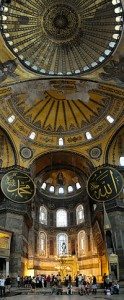Week 7: Tuesday, November 17, 2015
Rome in the East
By the 300’s AD, the leadership of the Roman Empire was divided among several locations: Rome, Milan, and in the east a new city that would become the favorite residence for the new leader Constantine. During his lifetime and that of his direct descendants, this new city on the Bosporus straits, Constantinople, became more and more the real capital of the Roman Empire. The eastern provinces were rich and often more peaceful than the European provinces within which order was breaking down. By the 500’s the Emperors ruled from Constantinople and their Italain viceroys reported to the Eastern capital. With the Lombard invasions and the Islamic attacks during the 700’s the ties between East and West were broken. The Italain peninsula was thrown more and more onto its own reserves with no help from the Christian East. And in the East, the imperial city evolved into something new: no longer a “Roman” city or a “Roman” empire, it now began what would be a one-thousand-year journey: Byzantium.
PART TWO: PICTURES
Constantinople
RECOMMENDED READING
The best book on this subject for the years (300-1000) that interest us in our Medieval Italy course is this first volume of a three-volume study by John Julius Norwich.

John Julius Norwich,
Byzantium (Vol I): The Early Centuries,
Alfred Knopf, 1989,
ISBN 0394537785
REVIEW: From Library Journal:
Several works dealing with Byzantine history have recently appeared (see Nicolas Cheetham's Medieval Greece, and Antony Bridge's Theodora,, but this is probably the most comprehensive survey for the general reader and tourist. The first of a projected three-volume study, this elegantly written tribute to the Western debt to Byzantium traces the history of the city from the birth of Constantine c.274 to the coronation of Charlemagne on Christmas Day 800. While slight attention is given to ordinary people, and the approach is very Eurocentric, all the great figures of early Byzantine history are here; the architectural monuments, theological controversies, the notorious sexual tastes of many emperors, and the proverbially "Byzantine" court intrigues are lucidly described.
Bennett D. Hill, Georgetown Univ., Washington, D.C.
AMAZON CUSTOMER REVIEW:
The perfect introduction to Byzantium! By Thomas J. Brucia on September 4, 2000 Format: Hardcover If you love history, and exploring unknown territory, this book is a winner! This historical narrative, complete with excellent and detailed maps, useful family trees, an extensive bibliography, and even a "List of Byzantine monuments surviving in Istanbul" (!) makes one feel like one is awaking from a coma. John Julius Norwich states: "During my five years at one of England's oldest and finest public schools, Byzantium seems to have been the victim of a conspiracy of silence. I cannot remember its being mentioned, far less studied... " This book is the cure! ---- Norwich's narrative is witty, fascinating, and informative and makes clear the huge debt Western European civilization owes to Byzantium, which shielded Europe first from the Persians, and then from Islam. (Look at your maps!) The first Christian emperor, Constantine the Great founded The Eastern Roman Empire (aka Byzantium) in 330. The Eastern Empire fell -- 1,123 years later -- in 1453 (quite a big educational gap!) This first volume (Byzantium is a trilogy!) ends at the coronation of Charlemagne as Roman Emperor of the West in the year 800. Norwich demonstrates that the Roman Empire never fell; it divided. His story is that of the Eastern Empire, but he fully examines Byzantine relations with the Papacy, Byzantium's presence in Italy, and military and diplomatic actions involving the remnants of the Western Roman Empire ----- Lord Norwich's writing style could be likened to a thread of gold (narrative) strung with countless jewels (anecdotes). This book covers five centuries and 88 rulers - and it is full of fascinating vignettes. It recapitulates the adoption of Christianity by the Roman Empire.
